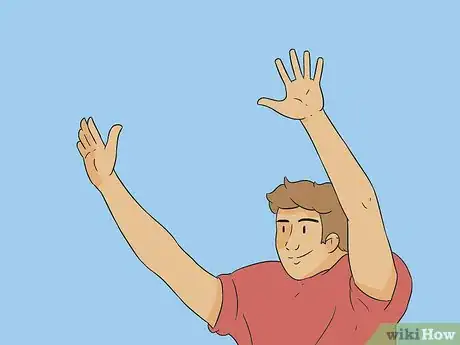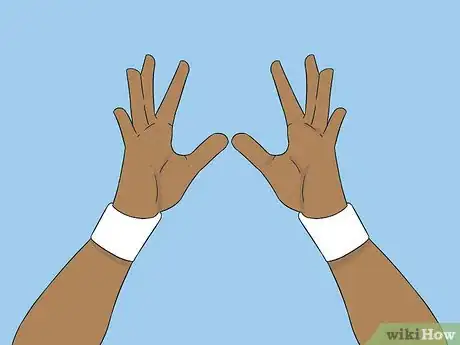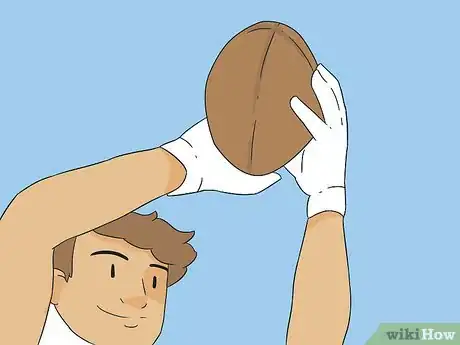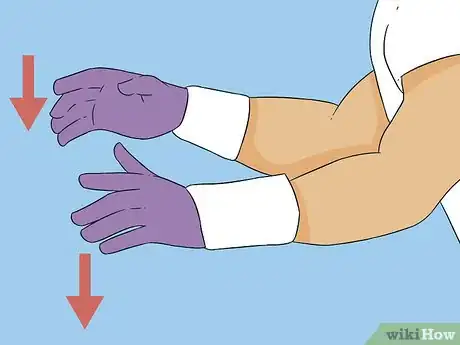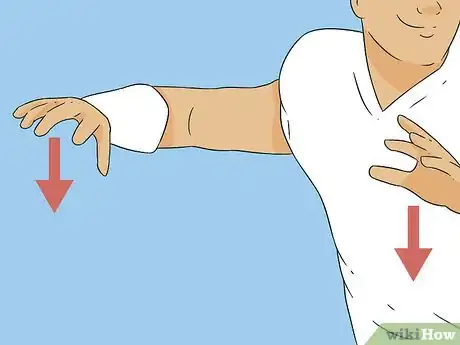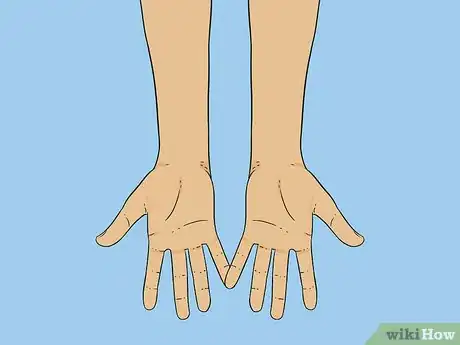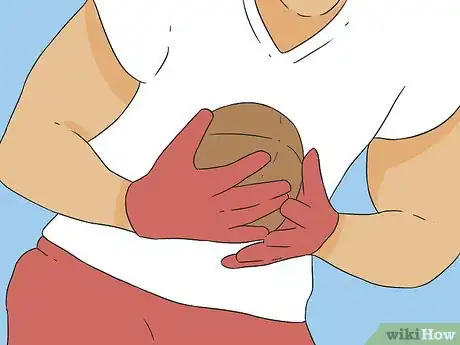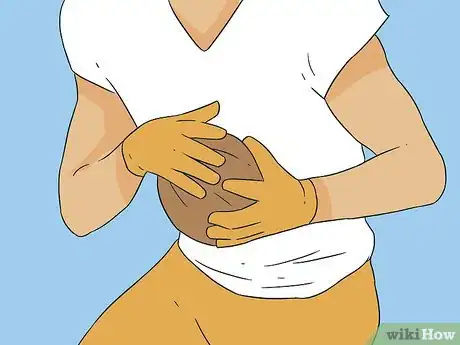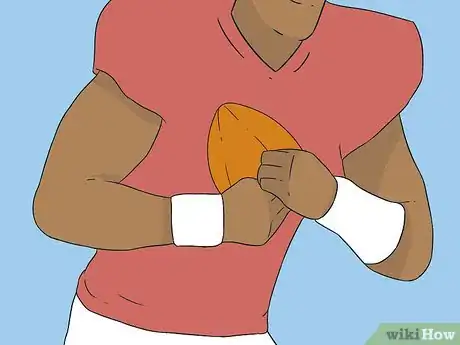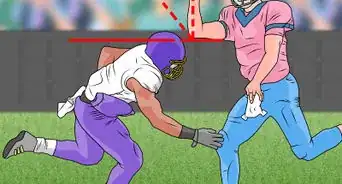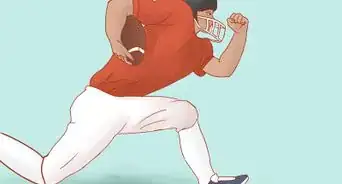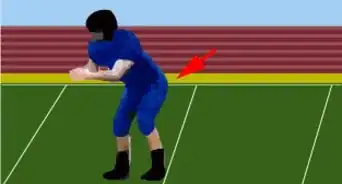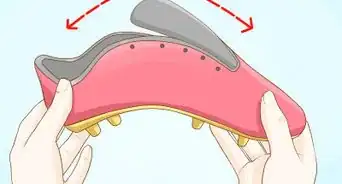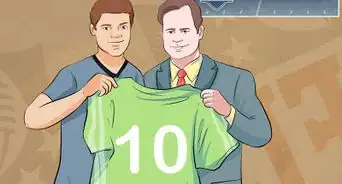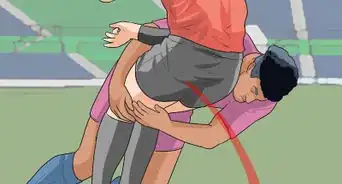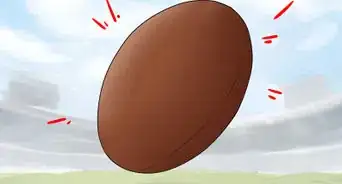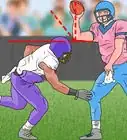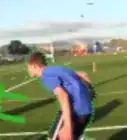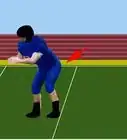This article was co-authored by wikiHow staff writer, Kyle Hall. Kyle Hall works on the content team at wikiHow. He helps manage our team of editors and creates content for a variety of wikiHow projects. Kyle continually looks for new ways to improve the content at wikiHow and make it more helpful and enjoyable for readers. He graduated from Eckerd College in 2015, where he majored in Political Science.
wikiHow marks an article as reader-approved once it receives enough positive feedback. In this case, 94% of readers who voted found the article helpful, earning it our reader-approved status.
This article has been viewed 444,506 times.
Learn more...
Whether you want to play football on a team or in a backyard with your friends, learning how to catch the ball is a must. The way you catch a football depends on what kind of pass you're receiving, but there are some general rules you should always follow, like keeping your eye on the ball at all times. By practicing regularly and working on your form, you can start catching the football whenever it's passed to you.
Steps
Practicing Good Catching Form
-
1Keep your eyes on the football. You want to be watching the football the entire time it's in the air. Pick a spot on the football - the white strip or the tip of the ball - and lock your eyes on that spot until the ball is in your hands.[1]
-
2Use your fingers to catch the football, not your palms. Your fingers should be the first thing to come into contact with the ball. Make sure they're slightly bent and ready to grab onto the ball when it comes your way.[2]
- If you're hearing a loud thud noise every time you catch the ball, you might be catching with your palms and not your fingers.[3]
Advertisement -
3Catch the football with soft hands. Soft hands are when your fingers and wrists are flexible and slightly relaxed. You want your hands to give a little bit when they come into contact with the ball. Catching with stiff, hard hands makes it more likely that the ball will bounce off you when you try to catch it.[4]
-
4Keep your arms extended away from your body. Whether you're catching a regular pass (above the waist) or a low pass (below the waist), you want your arms to be slightly bent and extended outward. Extending your arms will give them room to respond to the impact when you catch the ball.[5]
Catching an Accurate or High Pass
-
1Raise your hands so they're in line with where the football is heading. You want to track which direction the football is heading in so you can get your hands in the right spot to catch it.
- For example, if you're running for the football and it's on your left, raise your arms up and extend them out to the left.
-
2Reach high for the football if it's a high pass. Stretch both of your arms up above your head so you're ready to catch the ball when it passes over you. You can also jump into the air with your arms stretched upward to help you reach the ball.
-
3Make a diamond shape with your hands. Spread your fingers apart on both hands so they're completely stretched out. With your palms facing outward, touch the tips of your two pointer fingers together and the tips of your thumbs together. This will create a diamond shape between your two hands.[6]
-
4Catch the tip of the football in the diamond shape when it reaches your hands. The tip of the football should go through the diamond and then stop once the center of the ball comes into contact with your hands.[7]
-
5Squeeze your fingers around the outside of the football. The tips of your fingers should be firmly gripped on the football so it's secure in your hands.[8]
-
6Use both hands to tuck the ball between your biceps and your chest. Hold the ball against your biceps and chest using the hand on that side of the body. Let go of the football with your other hand. Now run with the football before someone tackles you.[9]
Receiving a Low Pass
-
1Lower your hands so they're ready to receive the low pass. Line them up with the trajectory of the football.[10]
- For example, if you see the football flying through the air at around the same level as your hips, move your hands down toward your hips so they're prepared to catch the ball.
-
2Turn your hands so your fingers are pointing down at the ground. The palms of your hands should be facing out toward the ball. Keep your fingers stretched apart.[11]
-
3Cross your pinky fingers so they form an “x” shape. Make sure your pinky fingers are firmly pressed together so the football doesn't slide through your hands when you catch it.
- Practice positioning your hands like this when you're not playing football so it comes naturally when you're on the field.
-
4Catch the tip of the football in the open space above your crossed pinky fingers. The tip of the football should go through the gap and then stop once the rest of the ball meets your hands.
-
5Squeeze your other fingers around the football to secure your catch. Bring the tips of your thumbs up and around the outside of the football and clamp them down on the ball. Wrap the rest of your fingers around the bottom of the ball.
-
6Lift the ball up and tuck it between your chest and biceps. Hold the ball in place using the hand on that side of your body. Let go of the ball with your other hand and start running to the end zone.
Community Q&A
-
QuestionHow can I catch a bullet pass?
 Community AnswerKeep as much focus as possible on the ball as it flies and try to estimate where the throw will go. Keep your hand waiting there in a catching position. Also, move your hand back slightly when the ball comes to cushion the impact.
Community AnswerKeep as much focus as possible on the ball as it flies and try to estimate where the throw will go. Keep your hand waiting there in a catching position. Also, move your hand back slightly when the ball comes to cushion the impact. -
QuestionHow do I get better at catching in traffic?
 DonaganTop AnswererIt's a matter of concentration. You have to convince yourself that at that moment the only things that exist are you and the ball. Once you've completed the catch, then you immediately look for your opponents and your teammates.
DonaganTop AnswererIt's a matter of concentration. You have to convince yourself that at that moment the only things that exist are you and the ball. Once you've completed the catch, then you immediately look for your opponents and your teammates. -
QuestionI'm a short receiver, so in the game the QB barely looks my way, but when he does I catch it. Should I go to RB, or what?
 Community AnswerPractice makes perfect and short receivers are usually fast, so if you can actually get past your defender then the QB should see you wide open and you'll get the ball.
Community AnswerPractice makes perfect and short receivers are usually fast, so if you can actually get past your defender then the QB should see you wide open and you'll get the ball.
References
- ↑ http://online.wsj.com/public/resources/documents/Chapter02.pdf
- ↑ http://online.wsj.com/public/resources/documents/Chapter02.pdf
- ↑ http://online.wsj.com/public/resources/documents/Chapter02.pdf
- ↑ http://online.wsj.com/public/resources/documents/Chapter02.pdf
- ↑ http://online.wsj.com/public/resources/documents/Chapter02.pdf
- ↑ https://www.youtube.com/watch?v=LRYc_kUdraA&feature=youtu.be&t=37
- ↑ https://www.youtube.com/watch?v=LRYc_kUdraA&feature=youtu.be&t=46
- ↑ https://www.youtube.com/watch?v=LRYc_kUdraA&feature=youtu.be&t=50
- ↑ https://www.youtube.com/watch?v=LRYc_kUdraA&feature=youtu.be&t=53
About This Article
To catch a football, make sure to keep your eyes on a specific spot on the ball, like the tip of the ball, the entire time it’s in the air. Then, use your fingers to catch the ball instead of your palms. Additionally, try to catch with “soft hands,” which means that your fingers and wrists are flexible and slightly relaxed. When you’re catching a pass, keep your arms slightly bent and extended away from you so they have room to respond to the impact when you catch the ball. For more tips, like how to catch a high and low pass, keep reading!




